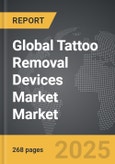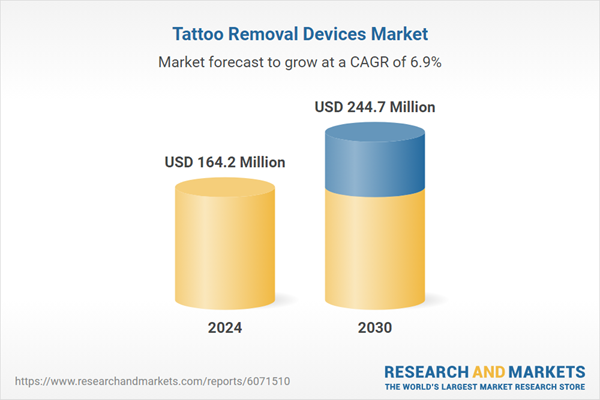Global Tattoo Removal Devices Market - Key Trends & Drivers Summarized
Why Is Tattoo Removal Experiencing a Surge in Demand Across Demographics and Regions?
Once considered a permanent commitment, tattoos are increasingly being re-evaluated by a growing number of people, prompting an unprecedented rise in demand for professional tattoo removal services. Changing personal circumstances, shifts in social identity, aesthetic preferences, and workplace requirements are among the key reasons individuals seek to erase or modify existing body art. The rise in tattoo regret, especially among younger demographics who obtained tattoos in their teenage or early adult years, has contributed to the growing interest in laser-based removal. Simultaneously, the increasing visibility of tattoos in mainstream culture has led to more people getting inked, which inevitably expands the potential market for removals. In many cases, tattoo modification or fading is sought as a preparatory step for a cover-up or redesign, creating demand for partial or precision-based removal techniques. Beyond personal choice, professional standards in sectors like healthcare, law enforcement, military, and hospitality sometimes necessitate tattoo removal for regulatory or image reasons. Social and cultural perceptions are also evolving - what was once a stigma for having tattoos is now being paralleled by the normalization of having them removed. With social media and image-consciousness playing a greater role in self-representation, individuals are turning to tattoo removal services as part of broader aesthetic and lifestyle transformations. As tattoo artistry becomes more complex and prevalent, so too does the need for effective, safe, and technologically advanced removal options.How Are Advances in Technology Enhancing the Safety, Speed, and Precision of Tattoo Removal?
Tattoo removal devices have undergone a significant transformation over the past decade, with technological innovations leading to safer, faster, and more effective treatment outcomes. The most notable shift has been the introduction of Q-switched lasers and, more recently, picosecond lasers, which deliver ultra-short pulses of energy to shatter tattoo pigments without causing excessive damage to surrounding skin tissues. Picosecond laser systems are particularly effective at targeting stubborn ink colors like blue, green, and red, which have historically been more resistant to traditional removal methods. These devices work through photomechanical and photoacoustic effects, fragmenting ink particles into tiny particles that are then cleared by the body's lymphatic system. New-generation lasers also feature variable wavelengths - such as 532 nm, 755 nm, and 1064 nm - enabling operators to treat a broader spectrum of ink colors and skin types with enhanced safety profiles. Real-time skin monitoring, spot-size adjustability, and integrated cooling technologies are improving patient comfort and reducing the risk of burns, scarring, and hyperpigmentation. Moreover, portable and compact systems are making it easier for smaller dermatology clinics and aesthetic centers to offer professional-grade removal services. Hybrid platforms that combine tattoo removal capabilities with skin rejuvenation functions are gaining popularity among practitioners seeking equipment versatility. As device costs decrease and clinical efficacy increases, both consumers and providers are finding laser tattoo removal to be a more accessible and compelling aesthetic service.Where Is Tattoo Removal Gaining Market Traction, and What Customer Segments Are Driving Demand?
Tattoo removal is gaining significant market traction in both developed and developing regions, with consumer demand expanding across diverse age groups, professions, and cultural backgrounds. In North America and Western Europe, where tattoo prevalence is high and aesthetic dermatology is well-established, the tattoo removal segment is experiencing rapid growth fueled by repeat customers, aesthetic clinics, and medspa chains. Urban centers with high concentrations of young professionals and university populations tend to be hotbeds of demand, particularly as attitudes toward personal branding and social presentation shift. In Asia-Pacific, particularly in countries like South Korea, Japan, India, and Australia, rising disposable income and growing awareness of aesthetic procedures are contributing to higher adoption of laser-based tattoo removal. In countries where tattoos have cultural or social stigma - such as parts of the Middle East - demand is often driven by individuals seeking to remove visible tattoos to improve employability or social acceptance. The expansion of medical tourism is also playing a role, with patients traveling abroad to undergo affordable and high-quality tattoo removal treatments. Among the fastest-growing customer segments are women seeking aesthetic refinements, individuals removing names or symbols linked to past relationships, and professionals undergoing tattoo removal as part of career transitions. Clinics and practitioners are increasingly offering financing options, personalized treatment plans, and bundled aesthetic services to cater to a broader range of consumers. Digital marketing, before-and-after imagery, influencer endorsements, and online booking platforms are also driving client acquisition and normalizing tattoo removal as part of the broader cosmetic procedure ecosystem.What's Fueling the Growth of the Global Tattoo Removal Devices Market?
The global tattoo removal devices market is growing rapidly due to a combination of social, technological, economic, and industry-specific factors. The rising number of people getting tattoos globally - driven by cultural acceptance and artistic expression - is creating a large installed base of potential removal candidates. The increasing incidence of tattoo regret, lifestyle changes, or professional limitations is pushing individuals to seek out removal solutions that are fast, effective, and minimally invasive. Technological advancements, especially in picosecond laser platforms, are expanding the types of tattoos that can be effectively treated and reducing the number of sessions required - making treatments more appealing to cost- and time-conscious consumers. As aesthetic medicine and dermatology clinics diversify their service offerings, tattoo removal is emerging as a high-margin procedure that can complement other skin treatments. Favorable regulatory environments, along with the growing acceptance of energy-based devices for cosmetic use, are making it easier for providers to enter the market. In emerging economies, improving access to technology, rising middle-class wealth, and expanding awareness of dermatologic care are opening new growth frontiers. Manufacturers are responding with portable, cost-efficient, and user-friendly devices that cater to a broader provider base. Meanwhile, the influence of social media, online reviews, and visual culture is making consumers more aware of their options and less hesitant to undergo tattoo removal. As these trends converge, tattoo removal is shifting from a niche corrective procedure to a mainstream aesthetic service - driving sustained growth in equipment sales, service adoption, and global market expansion.Report Scope
The report analyzes the Tattoo Removal Devices market, presented in terms of market value (US$). The analysis covers the key segments and geographic regions outlined below:- Segments: Device (Laser Devices, Radiofrequency Devices, Ultrasound Devices); End-Use (Dermatology Clinics, Medical Spa & Beauty Centers).
- Geographic Regions/Countries: World; United States; Canada; Japan; China; Europe (France; Germany; Italy; United Kingdom; Spain; Russia; and Rest of Europe); Asia-Pacific (Australia; India; South Korea; and Rest of Asia-Pacific); Latin America (Argentina; Brazil; Mexico; and Rest of Latin America); Middle East (Iran; Israel; Saudi Arabia; United Arab Emirates; and Rest of Middle East); and Africa.
Key Insights:
- Market Growth: Understand the significant growth trajectory of the Laser Devices segment, which is expected to reach US$145.2 Million by 2030 with a CAGR of a 6%. The Radiofrequency Devices segment is also set to grow at 7.9% CAGR over the analysis period.
- Regional Analysis: Gain insights into the U.S. market, valued at $44.7 Million in 2024, and China, forecasted to grow at an impressive 10.6% CAGR to reach $50.5 Million by 2030. Discover growth trends in other key regions, including Japan, Canada, Germany, and the Asia-Pacific.
Why You Should Buy This Report:
- Detailed Market Analysis: Access a thorough analysis of the Global Tattoo Removal Devices Market, covering all major geographic regions and market segments.
- Competitive Insights: Get an overview of the competitive landscape, including the market presence of major players across different geographies.
- Future Trends and Drivers: Understand the key trends and drivers shaping the future of the Global Tattoo Removal Devices Market.
- Actionable Insights: Benefit from actionable insights that can help you identify new revenue opportunities and make strategic business decisions.
Key Questions Answered:
- How is the Global Tattoo Removal Devices Market expected to evolve by 2030?
- What are the main drivers and restraints affecting the market?
- Which market segments will grow the most over the forecast period?
- How will market shares for different regions and segments change by 2030?
- Who are the leading players in the market, and what are their prospects?
Report Features:
- Comprehensive Market Data: Independent analysis of annual sales and market forecasts in US$ Million from 2024 to 2030.
- In-Depth Regional Analysis: Detailed insights into key markets, including the U.S., China, Japan, Canada, Europe, Asia-Pacific, Latin America, Middle East, and Africa.
- Company Profiles: Coverage of players such as Agilent Technologies, Inc., Azenta Life Sciences (GENEWIZ), BGI Genomics, Bio-Rad Laboratories, Inc., CD Genomics and more.
- Complimentary Updates: Receive free report updates for one year to keep you informed of the latest market developments.
Some of the 34 companies featured in this Tattoo Removal Devices market report include:
- Alma Lasers Ltd.
- Asclepion Laser Technologies GmbH
- Astanza Laser LLC
- Beijing Sanhe Beauty
- Beijing Sea Heart International Science and Technology
- Candela Medical
- Chengji Electronic Technology
- Cryomed Aesthetics
- Cutera, Inc.
- DEKA M.E.L.A. s.r.l.
- Fotona d.o.o.
- Golden Laser
- Hologic, Inc. (Cynosure, Inc.)
- Lumenis Ltd.
- Lutronic Corporation
- Lynton Lasers Ltd.
- NC Medical Systems
- Perfect Laser (Wuhan) Co., Ltd.
- Quanta System S.p.A.
- Rohrer Aesthetics
- Sciton, Inc.
- ShanDong EXFU Lasers Technology
This edition integrates the latest global trade and economic shifts into comprehensive market analysis. Key updates include:
- Tariff and Trade Impact: Insights into global tariff negotiations across 180+ countries, with analysis of supply chain turbulence, sourcing disruptions, and geographic realignment. Special focus on 2025 as a pivotal year for trade tensions, including updated perspectives on the Trump-era tariffs.
- Adjusted Forecasts and Analytics: Revised global and regional market forecasts through 2030, incorporating tariff effects, economic uncertainty, and structural changes in globalization. Includes historical analysis from 2015 to 2023.
- Strategic Market Dynamics: Evaluation of revised market prospects, regional outlooks, and key economic indicators such as population and urbanization trends.
- Innovation & Technology Trends: Latest developments in product and process innovation, emerging technologies, and key industry drivers shaping the competitive landscape.
- Competitive Intelligence: Updated global market share estimates for 2025, competitive positioning of major players (Strong/Active/Niche/Trivial), and refined focus on leading global brands and core players.
- Expert Insight & Commentary: Strategic analysis from economists, trade experts, and domain specialists to contextualize market shifts and identify emerging opportunities.
Table of Contents
Companies Mentioned (Partial List)
A selection of companies mentioned in this report includes, but is not limited to:
- Alma Lasers Ltd.
- Asclepion Laser Technologies GmbH
- Astanza Laser LLC
- Beijing Sanhe Beauty
- Beijing Sea Heart International Science and Technology
- Candela Medical
- Chengji Electronic Technology
- Cryomed Aesthetics
- Cutera, Inc.
- DEKA M.E.L.A. s.r.l.
- Fotona d.o.o.
- Golden Laser
- Hologic, Inc. (Cynosure, Inc.)
- Lumenis Ltd.
- Lutronic Corporation
- Lynton Lasers Ltd.
- NC Medical Systems
- Perfect Laser (Wuhan) Co., Ltd.
- Quanta System S.p.A.
- Rohrer Aesthetics
- Sciton, Inc.
- ShanDong EXFU Lasers Technology
Table Information
| Report Attribute | Details |
|---|---|
| No. of Pages | 268 |
| Published | December 2025 |
| Forecast Period | 2024 - 2030 |
| Estimated Market Value ( USD | $ 164.2 Million |
| Forecasted Market Value ( USD | $ 244.7 Million |
| Compound Annual Growth Rate | 6.9% |
| Regions Covered | Global |









